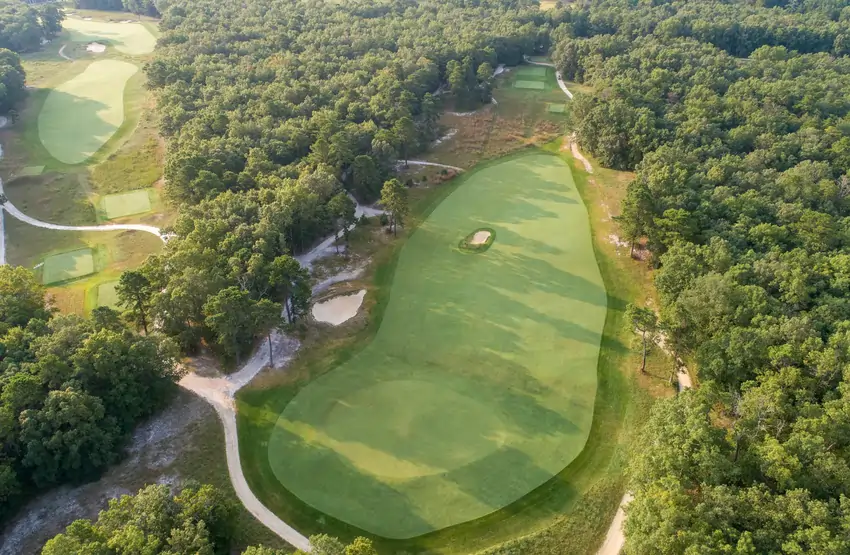Bandon Trails
A mid-career masterstroke from Coore & Crenshaw, Bandon Trails explores three distinct environments: dunes, meadow, and rain forest

Bandon, Oregon, USA
Coore & Crenshaw (original design, 2005)
Public
$$$
Bandon Dunes' Bandon Trails | Fried Egg Guides
Fried Egg Guides: Bandon Trails Roundtable
Bandon Deep Dives: Bandon Trails
Twenty years ago, as Bill Coore and Ben Crenshaw broke ground on the third course at Mike Keiser’s Bandon Dunes resort, they faced a difficult set of tasks. They had to build a course that could stand toe-to-toe with David McLay Kidd’s Bandon Dunes and Tom Doak’s Pacific Dunes; they needed to create a golf experience that would motivate guests to stay two nights instead of one; and they had to extract the full potential of a property that lacked ocean frontage. As soon as Bandon Trails opened in 2005, it was clear that Coore & Crenshaw had achieved these goals. Their deft routing and sensitive stewardship of the indigenous vegetation revealed a piece of land that was, in its way, just as alluring and unique as the ones Keiser had given to Kidd and Doak. If the first two courses established Bandon Dunes’ reputation, Trails proved that the resort wasn’t reliant on the coastline, that it could explore other landscapes. Evidently Keiser liked what he saw from Coore & Crenshaw; the Trails project was his first collaboration with them, and since then he and his sons have worked with the firm on several more new builds, including Bandon Preserve, Sand Valley, the Sandbox, and Sheep Ranch.
{{content-block-course-profile-bandon-trails-001}}
Take Note…
Trails. Long before Mike Keiser purchased it, the Bandon Trails property was crisscrossed by trails, some made by humans, others by animals. Bill Coore, who prefers to route courses by walking the land rather than studying topographical maps, made frequent use of these byways. Partly as a tribute to the site’s former identity, Coore & Crenshaw put a great deal of artistic effort into the trails that connected their holes.
Off-course. Tony Russell, a Bandon local and former dairy farmer, has contributed to the construction of every course at Bandon Dunes, including the 19-hole par-3 course Shorty’s, which will open this May. At Trails, Russell was tasked with clearing trees from the center lines of the hole corridors. On the 10th hole, as author Stephen Goodwin related in his book Dream Golf, Russell accidentally veered left, forcing Coore & Crenshaw to change their plans. Coore then jokingly appointed Russell a design associate (“You’re going to have to share the blame”), and the crew had “Coore & Crenshaw & Russell” hats made.
Squad. Speaking of associates, Coore & Crenshaw had a murderer’s row of them at Bandon Trails. Dave Axland ran the construction site, while Russell, Jim Craig, Jimbo Wright, Jeff Bradley, and a young Dave Zinkand shaped greens and bunkers. This team is surely one of the most talented in the history of the industry. (Several of Tom Doak’s crews from the same era, particularly the ones at Pacific Dunes and Ballyneal, belong in that conversation, too.)
Favorite Hole
No. 8, par 4, 321 yards
This beguiling short par 4 runs along the crest of the property’s main ridge. From the tee, the hole has an inviting appearance, especially for right-handers who can draw the ball. The fairway, framed by bunkers, curves gently from right to left, the land tilts in the same direction, and everything flows into the green’s broad, open front. Longer players will have a hard time keeping driver in the bag. While this aggression might be tactically sound, especially since approaches from the safe section of the fairway 100 yards out can be fiddly, those who go for the green and miss will face difficult recoveries from various bunkers, swales, and native plants.
Favorite Hole
No. 8, par 4, 321 yards
This beguiling short par 4 runs along the crest of the property’s main ridge. From the tee, the hole has an inviting appearance, especially for right-handers who can draw the ball. The fairway, framed by bunkers, curves gently from right to left, the land tilts in the same direction, and everything flows into the green’s broad, open front. Longer players will have a hard time keeping driver in the bag. While this aggression might be tactically sound, especially since approaches from the safe section of the fairway 100 yards out can be fiddly, those who go for the green and miss will face difficult recoveries from various bunkers, swales, and native plants.

{{content-block-course-profile-bandon-trails-002}}
Overall Thoughts
The genius of Bandon Trails lies primarily in its routing. Its strategic design is excellent, too, as is the shaping of the greens and bunkers. But what’s most impressive about the course, and what helps it compete with its seaside neighbors, is that its 18 holes unfurl over a vast, varied property with the easy coherence of an ancient walking path. This is a testament to Coore & Crenshaw’s mastery of routing—that is, their understanding of where to locate greens and tees, how to maximize the best features of a site, and how to connect all 18 holes into a single story with a beginning, middle, and end.
These tasks were immensely difficult at Bandon Trails. The property that Coore & Crenshaw ended up using was so intractable that, initially, Mike Keiser couldn’t imagine a functional golf course being laid out over it. On the architects’ first visit, Keiser took them straight to the upland rainforest where seven holes currently sit; he assumed that the entire course would have to be built there. Right away, though, Bill Coore saw a different possibility: a routing that started in the dunes below, climbed through a beautiful meadow of huckleberry and kinnikinnick, visited the woods at the top of a large ridge, then came back down. This concept would be far more likely to hold its own against Bandon Dunes and Pacific Dunes than a pure woodland layout. But it would require a lot of skill to pull off.
Coore & Crenshaw are more than capable of lending an awkward site a natural-seeming unity. They are longtime students of Alister MacKenzie’s routing at Cypress Point, which moves from grassland to forest to dunes to seaside cliffs without ever feeling disjointed. Just a year before Coore & Crenshaw began exploring the Trails property, they had finished a design at Friar’s Head that linked up big sand dunes by the Long Island Sound with a dead-flat potato field. Yet Bandon Trails represented an even greater routing challenge. Until well into the construction process, Coore & Crenshaw weren’t sure whether they could make the course feel like a single, organized whole.
Ultimately, they did. Their bold plan to connect dunes to meadow to woods worked out, and here are three reasons why:
1. Crossing points. C&C’s main practical difficulty at Bandon Trails was getting over the massive ridge running through the center of the site. (The same ridge borders the 18th hole at Pacific Dunes and divides Old Macdonald’s four inland holes from its seaward 14.) For the course to be walkable—as it would need to be, given that Bandon Dunes is a walking-only resort—C&C would have to create functional crossing points between the lower and upper sections of the property. They found an easy one at the par-4 seventh hole, which sneaks up a less severe part of the ridge. The exit from the high forest is more complicated, requiring a long, hilly commute between the 13th and 14th holes. But the land is so beautiful, the trail so well designed, and the reveal of the top-of-the-world 14th tee so dramatic that the transition becomes a pleasurable feature of the round rather than an annoying distraction from it. I recommend hiking, if you can, instead of taking the shuttle that the resort provides.
{{content-block-course-profile-bandon-trails-003}}
2. Segues. The connection between the 13th green and the 14th tee is one of many at Bandon Trails that gives coherence to what, in less capable hands, would have been an unpleasant hitch in the routing. Just as a writer uses segues to move between disparate ideas, C&C use trails to link up different chunks of land. The transition between Nos. 2 and 3 is a good example. Here, the course moves from dunes to meadow, and this change occurs step by step along the path from the second green to the third tee, as linksy marram grass gradually gives way to thicker vegetation and trees. Then the trail passes under the branches of a large conifer, and the transition is complete: the expanse of the third fairway, rolling through a meadow environment, is revealed. What could have been a disorienting smash cut is instead a smooth dissolve.

3. Structure and balance. The primary reason Bandon Trails hangs together as well as it does is that C&C’s routing uses the property’s three different environments in a structured way. The course begins and ends (Nos. 1, 2, and 18) in the dunes, creating a sense of departure from and return to the dominant ecosystem of the resort. The rest of the round unfolds in three phases: four holes in the meadow (3-6), seven in the upland woods (7-13), and four more in the meadow (14-17). Compare this precisely balanced organization with the unevenness of Robert Trent Jones’s Spyglass Hill, which spends its first five holes in the dunes and never returns.
(Sidebar: in a podcast discussion with Andy in 2022, I compared Bandon Trails’ routing to a narrative with a “frame story.” Think of the movie The Princess Bride: the scenes featuring Peter Falk reading to Fred Savage are the frame story—the “real world” events that ground and give context to the fantastical exploits of Westley, Buttercup, and Inigo Montoya. That’s how I think of the first, second, and last holes at Bandon Trails. Situated in the standard landscape of the Bandon Dunes resort, they serve as bookends for the mystical adventure through the meadow and rainforest. A bit of a stretch? Maybe, but if any golf course demands comparison to literature and film, it’s Trails.)
{{content-block-course-profile-bandon-trails-004}}
The strength of Bandon Trails’ routing conceals, even compensates for, the weakness of a few holes. The first and 18th sit on gorgeous, tumbling ground, but they don’t have much strategic substance; tee shots tend to settle in similar places. The ninth and 10th are by no means the worst holes at the resort, but they might be the most forgettable. And the par-5 16th is a straight-uphill slog, albeit one that connects a superb par 4 with a dazzling par 3.
Many players also criticize the 14th hole for its severe green, which has been softened in recent years, and the extreme difficulty of avoiding the big slope in the fairway that kicks balls toward oblivion on the right. But I think No. 14 is sufficiently playable, if exacting. Besides, I enjoy its provocative character, especially considering the rest of the course is mostly friendly and scoreable.
The criticisms of Bandon Trails’ lesser holes raise a question, however. Is the highest purpose of a golf architect to build 18 of the best possible individual holes? Or is it to take the golfer on a journey that reveals the beauties of a particular piece of land? Coore & Crenshaw prioritized the latter objective at Bandon Trails, and I’m glad they did.
2 Eggs
Of course, great holes and a great journey aren’t mutually exclusive, and Trails does falter occasionally on the former count. The course has also gone through agronomic struggles recently, with poa annua invading the fescue greens. As a result, playing conditions aren’t quite fiery enough to allow golfers to make consistent use of the ground-game options Coore & Crenshaw built into the greens and surrounds. Still, Bandon Trails is an obvious masterpiece—21st-century golf architecture at its peak.
Course Tour

{{content-block-course-profile-bandon-trails-005}}
Bandon Dunes' Bandon Trails | Fried Egg Guides
Leave a comment or start a discussion
Get full access to exclusive benefits from Fried Egg Golf
- Member-only content
- Community discussions forums
- Member-only experiences and early access to events

















Leave a comment or start a discussion
Lorem ipsum dolor sit amet, consectetur adipiscing elit. Suspendisse varius enim in eros elementum tristique. Duis cursus, mi quis viverra ornare, eros dolor interdum nulla, ut commodo diam libero vitae erat. Aenean faucibus nibh et justo cursus id rutrum lorem imperdiet. Nunc ut sem vitae risus tristique posuere. uis cursus, mi quis viverra ornare, eros dolor interdum nulla, ut commodo diam libero vitae erat. Aenean faucibus nibh et justo cursus id rutrum lorem imperdiet. Nunc ut sem vitae risus tristique posuere.